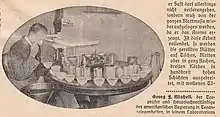Tea tasting
Tea tasting is the process in which a trained taster determines the quality of a particular tea.[1] Due to climatic conditions, topography, manufacturing process, and different clones of the Camellia sinensis plant (tea), the final product may have vastly differing flavours and appearance. These differences can be tasted by a trained taster in order to ascertain the quality prior to sale or possibly blending tea.[1]
_(7545204176).jpg.webp)
Techniques
The ISO 3103 standard describes a standardised method for brewing teas in order to make meaningful sensory comparisons between them. It is not a particularly useful standard for many teas, however, requiring a six-minute brewing time and boiling water, neither of which are recommended for green teas (usually brewed at < 90 °C and for under 3 minutes). Tea tasters would instead usually taste teas which have been brewed according to the recommendations of the producer.
A tea taster uses a large spoon and noisily slurps the liquid into his/her mouth - this ensures that both the tea and plenty of oxygen is passed over all the taste receptors on the tongue to give an even taste profile of the tea. The liquid is then usually spat back out into a spittoon before moving onto the next sample to taste. The flavour characteristics and indeed leaf colour, size and shape are graded using a specific language created by the tea industry to explain the overall quality. Generally speaking, once the quality has been tasted/graded, each tea company places a value on it based on market trends, availability and demand.

References
- Yvonne Wrightman (January 1994), All the Tea in China - Fascinating Traditions and Incredible Edibles, Centax Distribution, pp. 14–, ISBN 978-1-895292-35-0, retrieved March 4, 2013